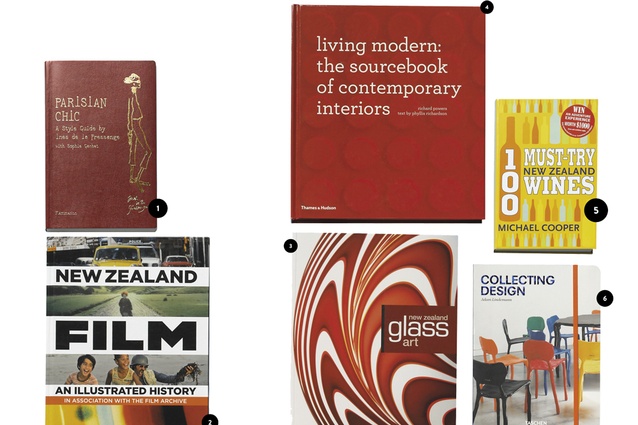Books on history of all things New Zealand
A history of all things New Zealand – film, glass and wine – along with some French style for a bit of variety.
Parisian Chic
Ines de la fressange
Flammarion, 2010
Parisian Chic is (as its subtitle explains) a style guide by Ines de la Fressange. A bit of background before you take style tips from her: she is a French model, aristocrat and fashion designer, and was inducted to the International Best Dressed List Hall of Fame in 1998. So maybe you do want to take style tips from her.
The book is a bit cloying with cutesy illustrations, snapshots ‘pinned’ to the pages, and handwritten cursive headlines. But if you get past all that, this is actually a good little book to have in your suitcase if you are planning on heading to the City of Lights. From clothing to beauty, as well as guide to the best places to shop, this book is full of tips and ideas. Alice liu
New Zealand film: An illustrated history
Diane Ppivac, Frank Stark and Lawrence McDonald
Te Papa Press, 2011
Sir Ian McKellen writes an eloquent and emotive foreward to this book on New Zealand Film. He talks about Sir Peter Jackson’s mockumentary Forgotten Silver about Colin McKenzie – a can-do, she’ll be right, adventurous, “thrusting spirit” who invented everything cinematic from celluloid to the close-up. That film was, of course, a spoof, but McKellen is quick to realise that that very spirit is exactly what has made the industry in this country. A well-researched history of film is interspersed with biographies on individual actors, directors, film events and moments. This is a cultural history told through our struggle (and success) of getting it on the screen. Adam Harrington
New Zealand Glass Art
David Bateman
David Bateman Ltd, 2010
If you are interested in glass art, this is a must-buy book. Offering a comprehensive overview on the broad range of artists working across New Zealand, this book shows the different styles of glass art, as well as the different practitioners and techniques. New Zealand is one of the world centres for glass art, so count yourself lucky. Ivan Gunner
Living Modern: The sourcebook of contemporary interiors
Richard Powers
Thames & Hudson, 2010
If your eyesight is failing, you might just like this book. Perhaps the author got a bit bored with the writing bit, or simply ran out of time, but the text is in a huge bold font, which somehow feels like Living Modern is yelling at you – the publishing equivalent of emailing in caps. For all of my cantankerous grumbling about fonts, this is a neat book. If you are looking to design a new home, do some renovations or work in design, this is a great resource. Separated in sections such as style (with sub-sections like minimal, retro and new-ethnic in it) or materials (wood, concrete, brick, etc), the book covers a huge amount of ground. Having been poring over books and magazines like this to gather ideas for a design project, I immediately see the benefit of having so many ideas pulled together into one place. I also appreciate that the houses tend to the architecturally designed. Nicole Stock
100 must-try New Zealand wines
Michael Cooper
Hachette New Zealand, 2010
Wines, like history class, are so centred on years. Yet, what I always preferred in history were the stories, the cause and event, the reasons for why the war started and ended as much as the dates. And it seems I also prefer this narrative when it comes to wine writing as well. In acclaimed wine expert Michael Cooper’s, new book 100 Must-Try New Zealand Wines, he focuses on different vineyards and varieties with barely a mention of years. Some are top of the range, others are best buys, but all have been judged as consistently worthwhile.
Starting with a winery and type, Cooper writes a short history of the family or company that makes the wine, describes the location, climate or soil, and then delves into the particularities of the wine’s taste. Without cluttering the book with too many tasting notes and keeping it brief, Cooper makes wine accessible and interesting. This is a trusty resource whether you want to impress, experiment or enjoy. Mia Flatt
Collecting Design
Adam Linderman
Taschen, 2010
I assumed this would be another flipbook of design pictures: good-looking chairs and tables, with some basic information about the designer and maybe hints of telltale brand motifs, but not much more than that. This book has been a pleasant surprise then when it has actually been revealed as something far more interesting. The book is divided into sections based on the five types of design market players – the designer, the collector, the dealer, the tastemaker, the auction house expert. Each section is
filled with first-person discussions by many different collectors/designers/tastemakers on their approach to design collecting. The in-depth interviews give you an insight into why one might collect, or why design is as fascinating and collectable as art. And yet, this isn’t just concepts or la-de-da ideas about collecting. For those who are looking for guidance, this is also a terrific resource. Within the personal essays, the individuals discuss particular works, specific styles and movements in design, which are illustrated. It means that one learns so much more about the pieces because this isn’t a bound stack of flashcards, but a selection of works that weave in and out of people’s professional worlds and private passions. Nicole Stock










